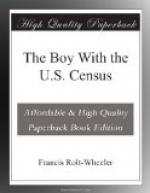The home manufacture of ostrich feathers first gave Hamilton a clear insight into poverty. Four or five rooms each occupied by a family of several persons he entered in one tenement, and in each he found three or four people working over ostrich plumes, working nervously at high speed, afraid to stop, even for a moment. He noted conditions carefully, and was amazed to find that each of the little strands was wired—he had always supposed that plumes grew upon the ostrich the way that they are sold.
In one such family dejection seemed to have reached its lowest ebb. The window looked out on a court,—a court that was never cleaned and where all manner of rubbish was thrown. Although it was morning and a brilliant, sunshiny day, the light within was so dim that it was hard to work by; yet with characteristic shiftlessness the window had not been washed for months and diminished still further the little light there was; a mattress in the opposite corner from a shaky cooking gas-burner showed that this room was the entire home.
[Illustration: TAKING THE CENSUS IN A CITY. Enumerator at a doorway, entering in his portfolio the details of a household.]
“Where is your husband?” asked the boy, noting on the schedule a man’s name as head of the family.
“In hospital—perhaps dead. See!”
The woman pointed to a telegram which had fallen to the floor. Hamilton picked it up. It read:
“John Sobieski worse. Come at once,” and was signed with the name of one of the large hospitals.
“Did you go?” asked the boy.
The woman shook her head.
“Two hours lost, if I go. No good. Two hours’ work means twenty-four cents. What’s the use?”
“What’s the matter with him?”
“Consumption. I die soon, next year, perhaps. All the children sick.”
The boy looked around at ‘all the children.’ There were five of them in that room, and all—even the youngest, a baby four years old—were knotting the feathers on the plume. The baby could hardly do it, but he was learning.
“Many hands make light work,” said Hamilton as cheerfully as he could. “With so many little workers you ought to get along finely.”
“Yes,” the woman answered listlessly, “we get along. Some days we make as much as a dollar!”
“Each of you?”
“Do we look so rich? One dollar for everybody. But that is only sometimes, when I am not too sick. We can get a little more than five dollar the week, by working all the time.”
The boy hastily asked the remaining questions on the schedule, found everything correctly reported and relieving his conscience by giving a little help out of his own pocket, he left for the next place.
On the floor below was a family working on fur, every one of them with hacking coughs caused by tiny particles of fur in the lungs.
“We work or we starve,” was again the unanswerable explanation.




